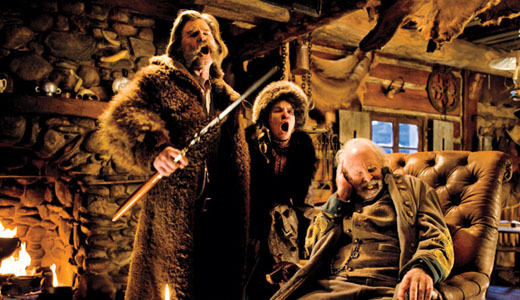Review: The Hateful Eight (70mm Roadshow Presentation) (2015)
Quentin Tarantino’s eighth feature film “The Hateful 8″ originally began it’s life as Tarantino’s crack at a novel detailing the further adventures of Jamie Foxx’s namesake hero Django from the director’s last film “Django Unchained.” Along the line, it transformed into an ensemble driven one-room set piece very reminiscent of the director’s first film “Reservoir Dogs.”
In fact, it’s easy to see a rough sketch of Django in the origin of the character of Major Warren, played by Samuel L. Jackson, a former Union cavalry officer in the Civil War turned bounty hunter. But while Django was a classic hero, Jackson’s Warren is a lovable rogue at best. “Hateful Eight” is populated by characters who are villains in deed, if not at heart. The premise finds Warren on his route to the town of Red Rock to collect a bounty on 3 cadavers when his horse is killed while travelling through a blizzard. He happens across a stagecoach rented by fellow bounty hunter John “The Hangman” Ruth, a bounty hunter who makes sure his bounties always make their way to the afterlife by means of a trial and a hanging, not by his handgun. He’s escorting an expensive bounty by the name of Daisy Domergue, played by veteran character actress Jennifer Jason-Leigh, to Red Rock. The blizzard that stalls Warren ultimately forces the trio to take shelter at a nearby haberdashery, where the bulk of the story takes place.
Consequently, the film is a result of several creative forces operating at the height of their craft. Tarantino has always said he doesn’t want to be considered a director who dabbles in westerns, but rather a western director in the mold of John Ford, Sergio Leone and Sergio Corbucci. While Django Unchained was an entertaining feature, it was Tarantino playing remix with the genre. In Hateful Eight, he takes some of his most valuable players from his past films, like Reservoir Dogs’ Tim Roth re-teaming with fellow castmate Michael Madsen, along with fellow Tarantino vets Samuel L. Jackson, Kurt Russell and Walton Goggins and lets them sing the director’s signature dialogue in a film that evokes and fits easily in the oeuvre of those director’s best work. Goggins makes a star turn stealing the film out from Samuel L. Jackson. Tarantino manages an exemplary and visceral performance from Russell; taking him from lovable rogue to bloodthirsty desperado in the same line of dialogue. Between Deathproof and Hateful Eight, Tarantino manages to find the nuanced bravado in Russell that John Carpenter did in the actor’s best work in the 1980’s.
Tarantino enlisted legendary composer Ennio Morricone (Leone’s The Main with No Name trilogy) to deliver an original score for the film to further enshrine it in the lexicon of the language of the Western. But along the way, he also allowed Tarantino use of some of his previous work, like unused queues from John Carpenter’s The Thing, a film that also seeks to invoke a sense of dread and suspense like The Hateful Eight does. One of the surprises I enjoyed was discovering a queue from Morricone’s score to The Exorcist 2: The Heretic used with deft as a chapter break.
Ultimately, the real star-maker in this endeavor is Tarantino’s use of the Ultra Panavision 70mm film system and lenses to film this piece. It draws out amazing detail on the performer’s faces, further creating a sense of claustrophobia and paranoia that perfectly frames many of character’s mindsets. It also may cause an Oscar nod for Jason-Leigh, whose bloody and increasingly battered visage throughout the film is hauntingly captured and framed through the film as the plot unfolds. While many assumed the use of 70mm was to capture the vistas of the mountain town, the lenses and cinematography gives remarkable focus to the performer and actions Tarantino wants you to see while making the rest of the field’s depth shallow or deep as it serves the film to hide or enhance details like a key or a bottle of poison.
The ideal way to see the film is in a roadshow presentation with a 6 minute overture of Morricone’s score and a 15 minute intermission with added narration by Tarantino himself and a handsome film program. Of Tarantino’s overall work, it is fine company with the better dialogue driven pieces of his oeuvre such as Jackie Brown and Reservoir Dogs, shying away from the more action oriented films like Inglorious Basterds or Pulp Fiction. The 2nd half of the film opens up and becomes very fast paced with amazing FX work from Howard Berger and Greg Nicotero known for the Walking Dead and a great 2nd act performance by Channing Tatum.
The Hateful Eight is a tour de force that needs to be seen on the big screen. It is a love letter to the experience of watching a film communally and to a genre that Tarantino has championed as one not lost to time. The western serves as a way to examine the nuance of human condition and how the better angels of our nature deal under extraordinary circumstance, a key theme in this film that Tarantino explores in all its highs and lows.
-
Cat Astrophy
-
victormoreno
-
Ruby
-
Adam Rutkowski
-
-
Adam Rutkowski
-
victormoreno
-
Adam Rutkowski
-
-
-
-



